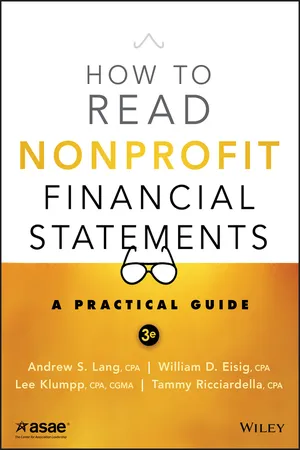
How to Read Nonprofit Financial Statements
A Practical Guide
- English
- ePUB (mobile friendly)
- Available on iOS & Android
How to Read Nonprofit Financial Statements
A Practical Guide
About this book
EXPERT GUIDANCE ON HOW TO READ, INTERPRET, AND USE NONPROFIT FINANCIAL STATEMENTS—UPDATED FOR THE NEW FASB STANDARD RELATED TO NONPROFIT FINANCIAL REPORTING (ASU 2016-14)
If you're an executive or volunteer leader at a nonprofit who is unfamiliar with the formats and language of financial statements, this book fills you in on how to read and correctly interpret those critical documents. If you're a seasoned pro who wants to brush up on your skills while familiarizing yourself with the latest FASB nonprofit reporting standards, this is the only guide you need.
The intent behind creating the ASU 2016-14 was to improve the clarity and usefulness of nonprofit financial statements, but making sense of those statements can still be tough going for the uninitiated. Accountants and non-accountants alike who use and prepare nonprofit financial statements need guidance on how to interpret and implement the new FASB standard. Written for both audiences, this book:
- Clearly defines accounting terminology and concepts, while offering numerous examples of financial statements reflecting both the old and new FASB standards
- Steers you, line-by-line, through financial reports, providing explanations of differences between the old and new standards
- Provides numerous illustrations that help you quickly feel at home with the format of nonprofit financial statements
- Offers exercises that help you gain insight into the concepts surrounding nonprofit financial statements and reinforce your command of those concepts
How to Read Nonprofit Financial Statements, Third Edition is an invaluable resource for everyone who reads, interprets, or prepares those all-important documents.
Frequently asked questions
- Essential is ideal for learners and professionals who enjoy exploring a wide range of subjects. Access the Essential Library with 800,000+ trusted titles and best-sellers across business, personal growth, and the humanities. Includes unlimited reading time and Standard Read Aloud voice.
- Complete: Perfect for advanced learners and researchers needing full, unrestricted access. Unlock 1.4M+ books across hundreds of subjects, including academic and specialized titles. The Complete Plan also includes advanced features like Premium Read Aloud and Research Assistant.
Please note we cannot support devices running on iOS 13 and Android 7 or earlier. Learn more about using the app.
Information
Chapter 1
Why You Need to Understand the Update to the Nonprofit Reporting Model
Chapter 2
Why Update the Nonprofit Reporting Model?
Chapter 3
Highlights of the Major Changes to the Nonprofit Reporting Model
Net Asset–Related Changes
Update to Net Asset Presentation
Disclosures of Board-Designated Net Assets
Update to Presentation of Underwater Endowments
Expirations of Capital Restrictions
Expense Reporting–Related Changes
Table of contents
- Cover
- Praise for How to Read Nonprofit Financial Statements
- Title Page
- Copyright
- Preface
- Learning Objectives
- Introduction
- Chapter 1: Why You Need to Understand the Update to the Nonprofit Reporting Model
- Chapter 2: Why Update the Nonprofit Reporting Model?
- Chapter 3: Highlights of the Major Changes to the Nonprofit Reporting Model
- Chapter 4: What Is the Purpose of Financial Statements?
- Chapter 5: Types of Financial Statements
- Chapter 6: How to Read a Nonprofit Financial Statement
- Chapter 7: Statement of Financial Position
- Chapter 8: Statement of Activities
- Chapter 9: Statement of Cash Flows
- Chapter 10: Statement of Functional Expenses
- Chapter 11: Footnotes to Financial Statements
- Chapter 12: Internal versus External (Audited) Financial Statements
- Chapter 13: The Independent Auditor's Report
- Chapter 14: Other Types of Auditor Opinions
- Chapter 15: Supplemental Information
- Chapter 16: Reserves
- Chapter 17: Financial Statement Exercises
- Chapter 18: Example Set 1
- Chapter 19: Example Set 2
- Chapter 20: Example Set 3
- Chapter 21: Financial Analysis
- Chapter 22: Benchmarking
- Chapter 23: Increasing Complexity in Nonprofit Financial Reporting
- Chapter 24: Nonprofits Subject to Government Auditing Standards and a Single Audit under the Uniform Guidance
- Glossary Prior to Effective Date of ASU 2016-14
- Glossary Amendments Made Upon Adoption of ASU 2016-14
- About the Authors
- Index
- End User License Agreement